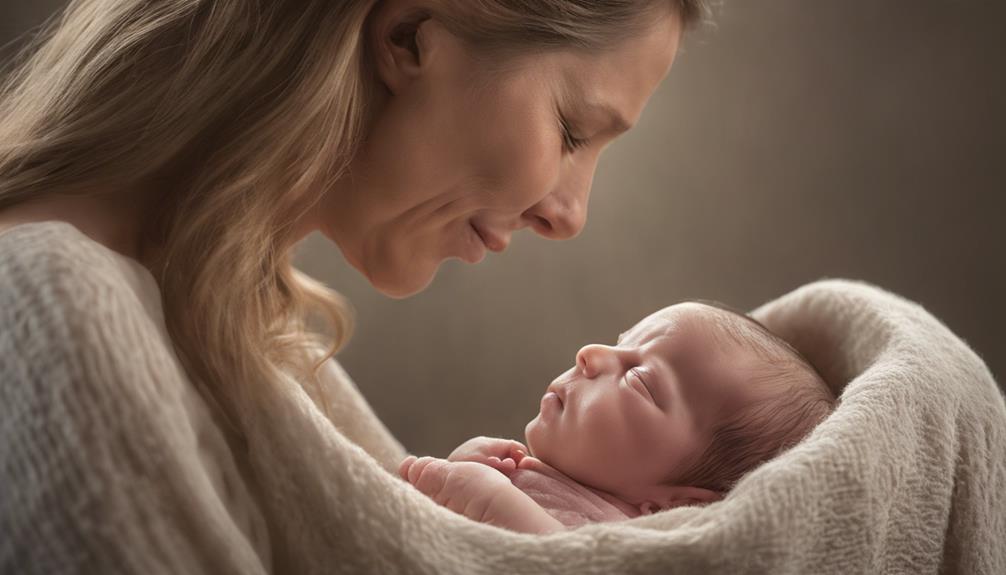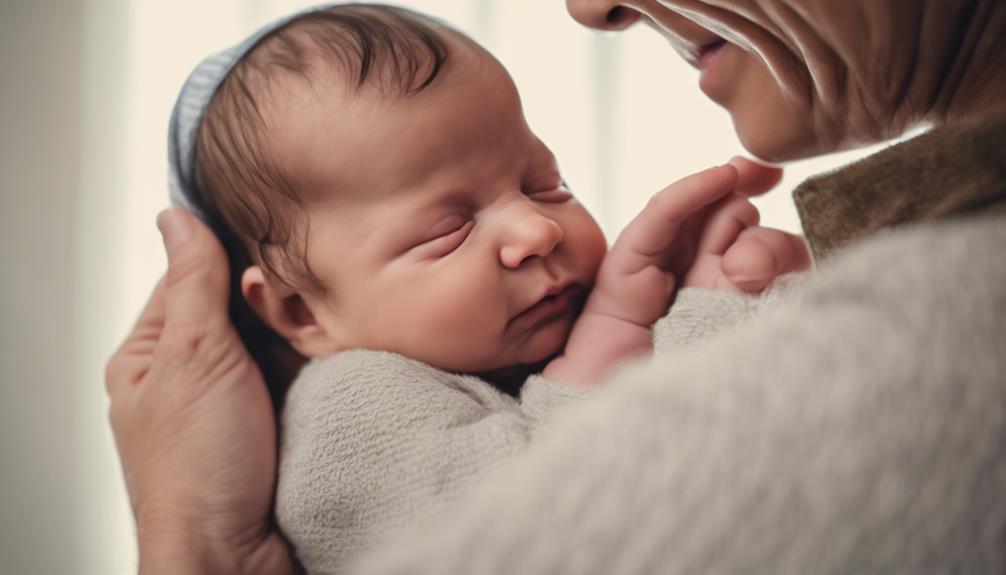Imagine newborn hiccups as tiny ripples in a calm pond, disrupting the tranquility of your baby's peaceful slumber. But fear not, for there are steps you can take to help ease this common occurrence.
By following a few simple techniques and strategies, you can minimize the discomfort your little one may experience.
Let's explore how you can navigate the world of newborn hiccups with confidence and care.
Key Takeaways
- Practice mindful feeding techniques to prevent newborn hiccups.
- Burp your baby frequently to release trapped air and reduce hiccups.
- Use upright feeding positions and proper latching to minimize air intake.
- Maintain a calm feeding environment with gentle pacing for a relaxed feeding experience.
Causes of Newborn Hiccups
Newborn hiccups can be triggered by various factors, including spasms of the diaphragm, swallowing air during feeding, overfeeding, or sudden changes in stomach temperature. Your baby's diaphragm, a vital muscle for breathing, can sometimes spasm, leading to those adorable yet persistent hiccups. When your little one gulps down air while feeding or takes in more milk than needed, hiccups may pay a visit. Sudden shifts in stomach temperature can also be a culprit in this hiccup saga. In addition, conditions like Gastroesophageal reflux disease (GERD) can contribute to frequent hiccups in babies.
Understanding these triggers is the first step towards prevention. By being mindful of feeding techniques, ensuring your baby isn't overeating, and keeping them comfortable in stable temperatures, you can help reduce the occurrence of hiccups. Remember, these hiccups are usually short-lived and normal in newborns, but a little prevention goes a long way in keeping them at bay.
Tips for Immediate Relief

To provide immediate relief for your newborn's hiccups, incorporating simple techniques into your routine can help alleviate discomfort and promote a calmer feeding experience. Remember to burp your baby frequently during and after feedings to release trapped air and prevent hiccups.
Holding your little one in an upright position for about 20-30 minutes after feeding can aid digestion and reduce the likelihood of hiccups. If you're bottle-feeding, try paced bottle feeding techniques to prevent your baby from swallowing excess air, which can lead to hiccups.
For breastfeeding moms, ensuring a proper latch is key to minimizing air intake and potential hiccups in newborns. Additionally, creating a calm and quiet feeding environment can help your baby feed slowly, preventing hiccups caused by gulping down milk too quickly.
Best Positions to Prevent Hiccups

For effective prevention of hiccups in your newborn, consider utilizing different feeding positions to minimize air intake and promote smoother digestion. Holding your baby in an upright position while feeding can help reduce the chances of hiccups by decreasing the amount of air swallowed. Using a nursing pillow for support during feeding can also guarantee proper positioning, minimizing the intake of air. Additionally, keeping your baby's head slightly elevated after feeds can aid in digestion and decrease the likelihood of hiccups occurring.
Ensuring a proper latch during breastfeeding is vital as it can help prevent your baby from swallowing excess air, which is a common cause of hiccups. Experimenting with various feeding positions, such as the laid-back position or side-lying position, can assist in finding the most effective method for preventing hiccups in your newborn. By paying attention to these details and adjusting feeding techniques, you can help your baby avoid the discomfort of frequent hiccups.
Feeding Strategies to Avoid Hiccups

Implementing proper feeding strategies can greatly reduce the occurrence of hiccups in your little one. Burping your newborn frequently during and after feedings helps release trapped air, lowering the chances of hiccups.
Using important feeding positions, like keeping your baby upright while feeding, minimizes the risk of hiccups by aiding digestion.
Ensuring a important latch during breastfeeding is important as it prevents your baby from swallowing excess air, a common cause of hiccups.
Offering smaller, more frequent feedings to your newborn can prevent overeating and decrease the likelihood of hiccups occurring.
Remember, creating a calm environment during feedings is essential for your newborn to focus on eating, reducing the chances of hiccups.
Creating a Calm Environment

To keep your newborn comfortable and minimize the chances of hiccups, creating a calm environment during feeding is key. Here are three essential steps to help you achieve a soothing and peaceful feeding environment:
- Maintain a quiet and soothing environment: Minimize distractions and loud noises that could startle or unsettle your baby. A peaceful atmosphere can help keep your little one calm and relaxed during feeding sessions.
- Guarantee proper lighting and temperature control: Create a comfortable feeding area with soft, dim lighting and maintain a suitable temperature to promote relaxation. A cozy environment can contribute to a more enjoyable feeding experience for both you and your newborn.
- Utilize a gentle feeding pace and proper positioning: Adopt a slow and steady feeding rhythm to reduce the risk of swallowing air, which can lead to hiccups. Additionally, make sure that your baby is positioned correctly to prevent hiccups and aid in digestion.
Frequently Asked Questions
How Do You Stop Hiccups in a Newborn?
To stop hiccups in a newborn, try burping them frequently during and after feedings to release trapped air. Using a pacifier can relax the diaphragm and potentially stop hiccups. Allowing hiccups to stop naturally within 5 to 10 minutes is safe and common.
Is It OK to Lay Baby Down With Hiccups?
It's perfectly fine to lay your baby down with hiccups since they generally don't affect breathing. If the hiccups persist and cause distress, consult a pediatrician for guidance. Keeping your baby upright can help with reflux-related hiccups.
What Is the Best Position for Baby Hiccups?
To prevent baby hiccups, hold them upright after feeding for at least 30 minutes. This position helps air escape easily, reducing hiccups. Avoid laying the baby flat right after feeding to lessen trapped air. Proper feeding techniques also help prevent excess air intake.
How to Avoid Hiccups?
To avoid hiccups, you can burp your baby frequently, make a good latch while breastfeeding, keep them upright after feeding, create a calm feeding environment, and prevent overfeeding. These steps help reduce air intake and digestion issues.
Conclusion
Remember, an ounce of prevention is worth a pound of cure when it comes to newborn hiccups.
By following these simple steps, you can help your baby avoid those pesky hiccups and keep them comfortable and happy.
So, take a deep breath, burp your baby regularly, and create a peaceful feeding environment to prevent those hiccups from interrupting your precious moments together.
Your baby will thank you for it!









